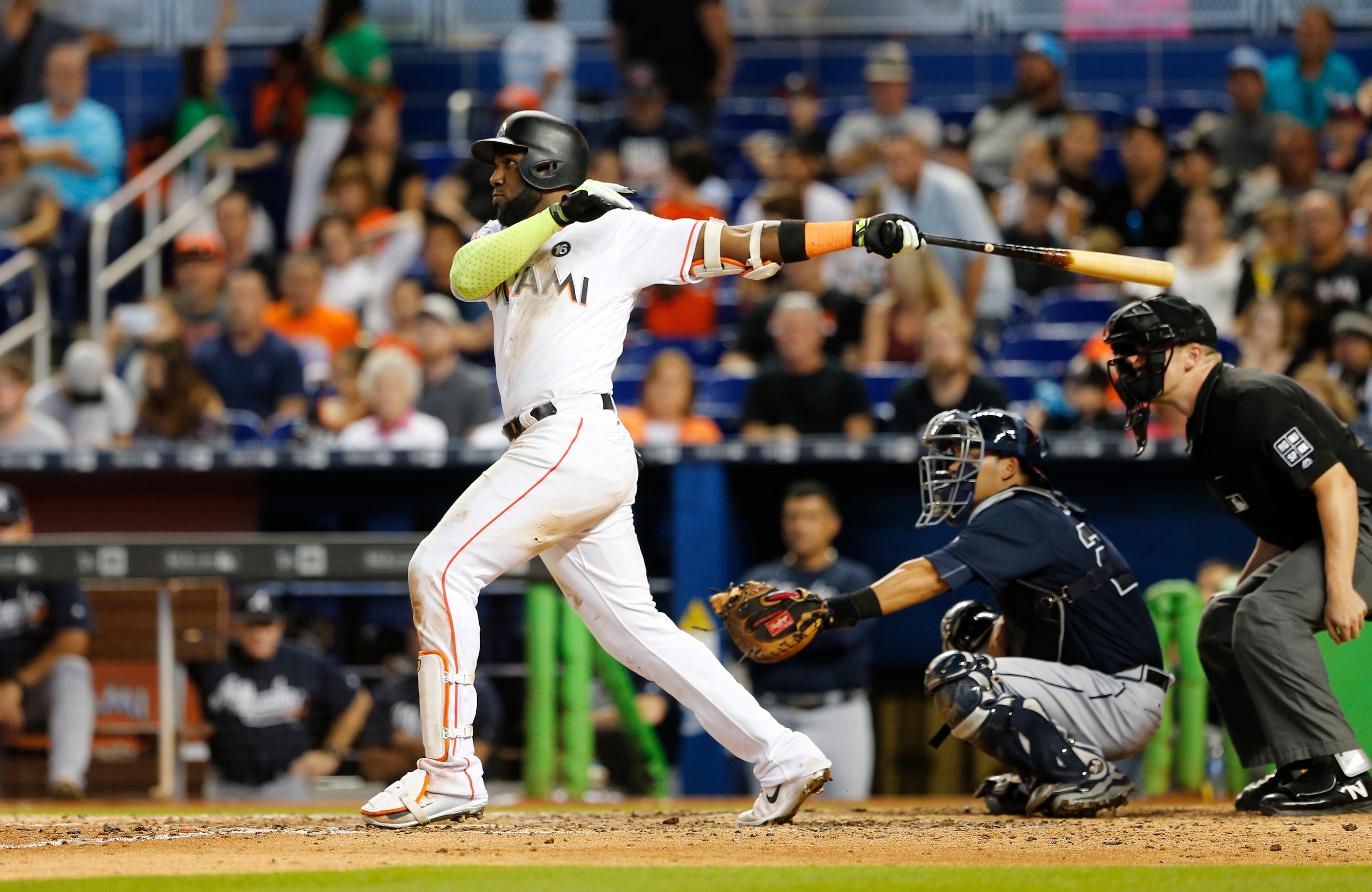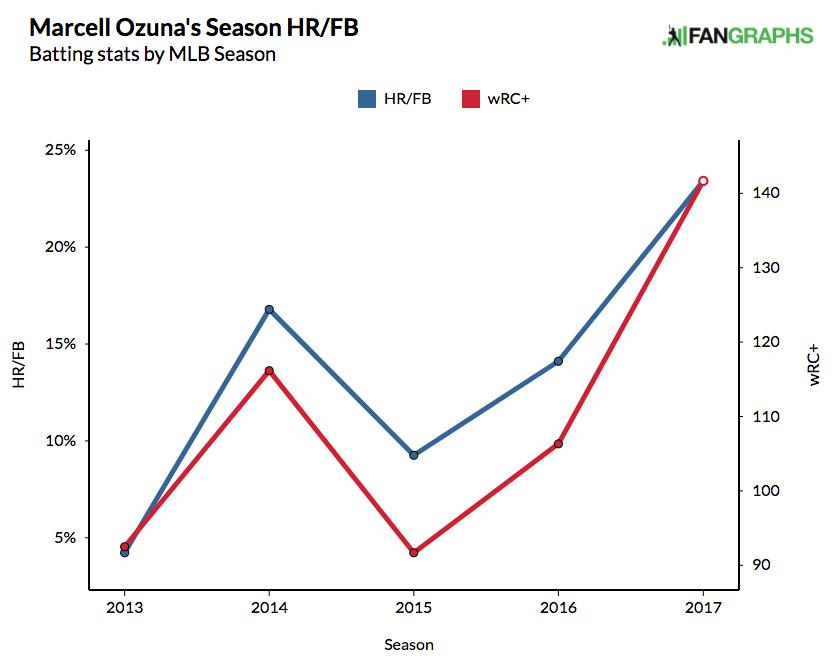
Congratulations, Cardinals fans—after weeks of negotiations with Miami’s new leadership group, your team is finally making a trade for a Marlins outfielder coming off an All-Star–and–Silver Slugger–winning season. Except, oh, it was the other such outfielder you were excited about? That’s awkward. Marcell Ozuna will still make your team better next season, as you try to chase down the vulnerable Cubs, but it’s not quite the same feeling as adding Giancarlo Stanton to the middle of the lineup.
Less than a week after Stanton wielded his no-trade clause to reject an agreed-upon deal to St. Louis, the Cardinals pivoted to Plan B and reportedly bolstered their lineup with Ozuna in exchange for a handful of lower-tier prospects. The move isn’t a home run like the Yankees’ sudden swiping of Stanton, but it yields an immediate upgrade for the Cardinals without too much potential downside. Once again, the Marlins help make a contender more fun.
The best interpretation of the trade for St. Louis is that its lineup had one hole, and the team just filled it with the best player available (non-Stanton division). Before making the trade, the Cardinals’ depth chart featured average or better players at seven of eight positions on the diamond, but—depending on how one feels about 2017 breakout outfielder Tommy Pham—no stars anywhere. The one position that wasn’t at least average was a corner outfield slot, which Ozuna will fill with aplomb: The Steamer projection system used by FanGraphs pegs Ozuna as a top-10 outfielder in the majors. (In a secondary move, the Cardinals appear poised to trade the player who would have started in Ozuna’s spot, Stephen Piscotty, to Oakland.)
Based on his performance last season, that ranking is deserved. Ozuna won a Gold Glove in 2017 and bashed 37 homers, more than he had in the previous two seasons combined, and his .312/.376/.548 slash line rated as 42 percent better than league average by wRC+—the same as those of MVP candidates Paul Goldschmidt and Anthony Rendon. In the past 14 years, the only other St. Louis outfielder to make an All-Star team in his 20s was Ryan Ludwick in his anomalous 2008 season, so it’s not a stretch to say that Ozuna is the best young outfielder to wear a Cardinals uniform since Albert Pujols, who played a few seasons in left before moving to first base.
The pessimistic viewpoint is that it’s unclear whether 2017 Ozuna represents the real Ozuna, rather than the versions that came before him. From his rookie year through 2016, he hit just 4 percent better than league average, tying him with the likes of Nori Aoki and placing him one point behind Denard Span.
He was slightly more aggressive at the plate last year, particularly on pitches in the strike zone, but not to any such extreme that it would account for his vast improvement. It appears more likely that his gains resulted more from external factors rather than any shift in approach. For instance, his .355 batting average on balls in play was the ninth-highest among qualified hitters, and even though Ozuna has run high BABIPs in the past, he still benefited from luck last season, as few hitters—most of them possessing the speed to beat out infield hits—outperformed their underlying batted-ball quality more than Ozuna did.
Before last year, 12.3 percent of Ozuna’s career fly balls had gone for home runs, but in 2017, that rate nearly doubled to 23.4 percent, which nudged Ozuna slightly ahead of Mike Trout in the statistic. Throughout his career, Ozuna’s overall performance has fluctuated in tune with his HR/FB rate, which itself is subject to plenty of random variation and overall statistical noise.

Perhaps the newest Cardinal is benefiting more than most players from the juiced ball—although that reason alone wouldn’t explain why he didn’t improve before 2017—or perhaps he just made a leap in his age-26 season. But it’s a safer bet that Ozuna just experienced his best season at the plate and that his true talent resides somewhere between league average and 42 percent better than that benchmark.
Still, every team in baseball—except the Marlins, apparently—would want to roster an outfielder who can field his position and hit somewhere in the range of 20 percent better than average, and as a player in his arbitration years, Ozuna comes much cheaper than most of his peers. He’s under team control for two more seasons before hitting free agency, during which time he should cost in the neighborhood of $25 million to $30 million, and St. Louis is at the point on the win curve where even minor upgrades matter most in helping a team reach the playoffs.
The Cardinals achieved that improvement without surrendering any of their top prospects. Right-handed pitching prospect Sandy Alcántara headlines Miami’s reported return package, which also includes three “less[er]-ilk” prospects, but the 22-year-old starter doesn’t rate as a top-100 prospect per MLB.com after his strikeout rate regressed from 29 percent at two levels of A-ball in 2016 to just 19 percent at Double-A last season. According to FanGraphs’ Eric Longenhagen, Alcántara’s breaking balls are ineffective, and his command issues mean “a full-time move to the bullpen might be coming soon.” Outfielder Magneuris Sierra, the other notable player moving to Miami, has a high floor because of his speed, but also the lower ceiling associated with any no-power prospect in baseball’s current iteration.
But such is the cycle of baseball life in Miami, where, as ESPN’s Sam Miller notes, the Marlins have now traded 21 of the franchise’s top 26 players by career WAR. Last year, the White Sox executed an immediate rebuild, exchanging young stars like Chris Sale and Adam Eaton for a glut of talented minor leaguers who could form the core of a contender in, say, 2020. Miami has taken a different tack so far this winter in its trades of Ozuna, Stanton, and Dee Gordon, aiming to shed salary more than add upside to the farm system. Outfielder Christian Yelich will be next, or perhaps catcher J.T. Realmuto, or someone else from the rapidly emptying major league roster. Prospective contenders should seize those opportunities; Miami just made St. Louis better without much of a fuss, but the fire sale won’t last for long.

